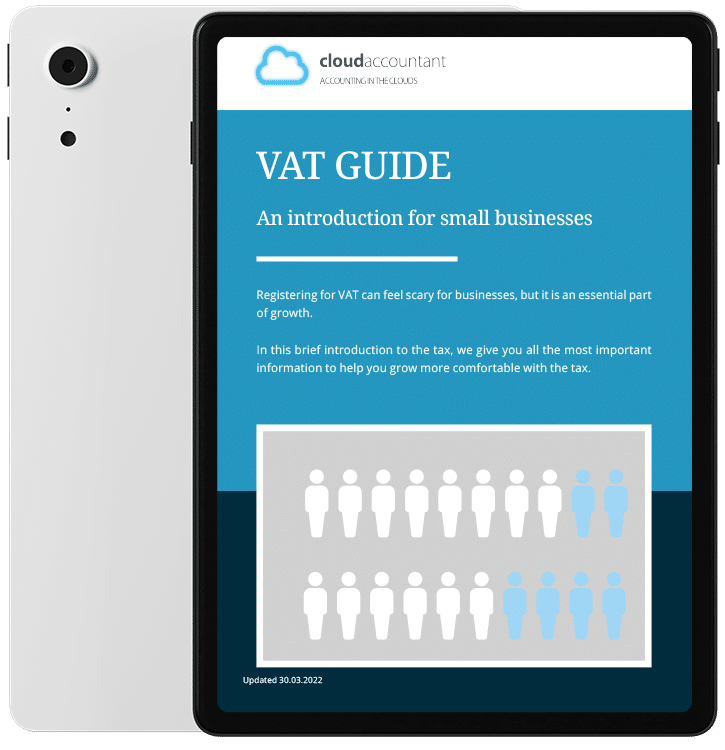VAT or Value Added Tax is a tax that’s applied to most goods or services. It’s paid by businesses and individuals, but not every business needs to charge VAT. VAT is collected on sales invoices and paid on purchase invoices with the net amount collected being paid across to HMRC after completion and submission of a VAT return. It’s so important to understand when to register for VAT. Directors can make the mistake of registering too late and risk being fined or registering earlier than necessary, creating a headache with additional filing requirements.
How does VAT work?
Sole traders, limited companies, and other businesses need to register for and charge VAT if their turnover exceeds £85,000 in a 12-month rolling period. If you think your turnover will exceed £85,000 in the next 30 days, you need to register your business for VAT immediately. If you are below the VAT threshold you can voluntarily sign up. Some businesses chose to do this as they feel charging VAT makes them appear more professional to their customers. It is also necessary if a business needs to take advantage of the Flat Rate Scheme – more of that later. Businesses must charge the standard rate of VAT (20%) on most goods and services. Some goods and services are subject to VAT at a discounted rate of 5%, while some products and services are exempt from VAT, including most food, children’s clothing, financial services, and insurance.
Becoming VAT registered means you charge more for your goods and services as your customers pay the total cost including VAT. You will need to keep this in mind, especially when your customer is an individual or a business that isn’t VAT registered as they cannot reclaim the VAT cost they’ve incurred. As a VAT-registered business, you can reclaim the VAT you pay on items for the business. You will pay VAT at the time of purchase but can reclaim (offset against your Sales VAT collected) when filing your return.
What is Making Tax Digital for VAT?
Making Tax Digital for VAT is the first step in the government’s tax digitisation programme.
Introduced in 2019, it means that all VAT-registered businesses in the UK need to file VAT returns using HMRC-approved software like FreeAgent or Xero.
The aim of MTD is to make the admin process for tax more efficient and simpler for the taxpayer.
There are plans to extend the scheme to Income Tax in 2023 and Corporation Tax by 2026.
How do I charge VAT?
There are a number of different VAT schemes that businesses can use to charge and pay VAT. It’s important you discuss which type of VAT scheme is the most appropriate for your business. You can change the VAT scheme you’re on at the end of a VAT period, which allows for flexibility if your circumstances change. The most common types of VAT schemes are:
• Standard VAT scheme
• Flat rate VAT scheme
Standard VAT scheme
All your sales and purchases must be recorded and a quarterly VAT return and payment submitted to HMRC. The amount you pay is calculated by deducting the VAT you’ve incurred in purchases from the VAT you’ve collected in Sales. If the former is higher, you’ll receive a refund.
Flat rate VAT scheme
The flat rate VAT scheme is only for businesses with a turnover of £150,000 per year or less and is popular with small businesses and sole traders. You still charge the standard VAT rates on your sales however you pay a lower fixed rate of VAT to HMRC. The rate you pay depends on the type of business and its principal activity. It does come with some restrictions including that you cannot reclaim VAT on purchases except for certain capital items over £2,000, such as furniture or computers. There is also a 1% discount for your first year as a VAT-registered business on the Flat Rate Scheme. If you are already registered under the Flat Rate Scheme and your turnover exceeds £230,000 you will have to change over to the standard scheme
Cash basis
Cash accounting means you only report the VAT figures on the Sales and purchases that have been paid for. So, if a customer is late paying the invoice, you won’t have to record this on your VAT return until you’ve received payment. Likewise, if you are charged VAT by your suppliers, you cannot reclaim this until you have paid the invoice. This scheme was designed to support cash flows in smaller businesses and avoid the scenario where you must pay VAT to HMRC before your customer has paid you. Understandably, this is a popular option for SMEs. This scheme is only available for businesses with a turnover below £1.35 million per year
Accrual basis
The figures are reported even if the invoices have not been paid by your customers which can put pressure on a business’s cash flow. It is important to have a system in place to ensure invoices get paid on time if there are several outstanding invoices, you can quickly run into issues that impact on the cash you have available to re-order stock, pay rent, salaries, etc.
When are VAT returns due?
For monthly and quarterly VAT returns, the deadline for submission is always one calendar month and seven days after the end of your VAT period e.g., if the quarter end is April, the VAT submission and payment is due by 7th June. Annual VAT returns are due 2 months after the end of the return period. You can see the full breakdown of VAT rates and the various schemes on the gov.uk website.
Annual accounting method
This is only available to businesses that turnover less than £1.35 million per year. Instead of filing your VAT return 4 times a year, you submit one every 12 months. You will pay HMRC quarterly or 10 times each year with an amount determined by your last VAT return. HMRC will write telling you when your installments are due and how much they’ll be. As the payments are an estimate, you may have to pay a ‘balancing fee’ to correct any discrepancies, in addition to the final payment for the year. Or you may be refunded for the overpayment. Although this option can help with budgeting throughout the year, the danger of an unexpected fee or overpaying and not being able to direct that money into growing the business means this is not a very popular way to manage VAT.
To learn more about small business VAT or for advice on which type of VAT is best for your business, speak to a member of the team today. Call: 01625 300 300.








